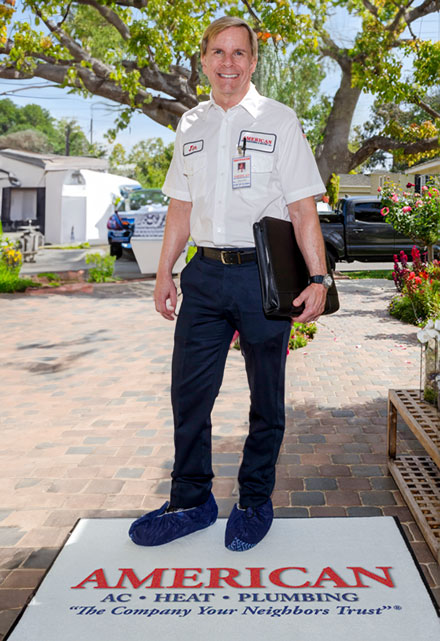With the summer heat rolling in, it is essential to ensure that the air conditioner for your home is the appropriate size to efficiently and successfully cool your space. Since the average American home in the United States is roughly 2,000 square feet, many wonder what size air conditioner will be applicable for that size. In addition, it’s essential to be aware that not all homes require the same air conditioner. So, to best suit your needs, make sure you pay special attention to the size of your air conditioner and the correct AC Installation in Burbank can frequently reach the upper 70s, 80s, and even 90s during this time of year, so prepping can help assure a comfortable home.
But if you’ve never purchased an air conditioner before, you may be wondering, “what size air conditioner do I need?” Well, the good news is that it comes down to a simple math equation based on the square footage of your home. However, before we take out the calculators, consider why it is crucial to consider sizing when choosing your air conditioner.

Why is it important to consider sizing?
In order to achieve maximum efficiency and comfort, it is crucial to make sure you have the correct size Air Conditioner for your home. Too small of an AC unit in space can cause it to be constantly running and your electricity bills will soar. If you choose an air conditioner that is too big, there is a good chance you will run into issues dealing with a problem known as Air Conditioning Short Cycling.
Air Conditioning Short Cycling occurs if an air conditioner cycles too frequently in seconds or minutes instead of completing an entire cooling cycle. In other words, your air conditioner will kick on, begin cooling, and stop after a short amount of time. It can lead to a high electricity bill, reduced air conditioner’s life because it has more increased wear, an air conditioner not performing its job, and possibly a visit from Emergency AC Repair in Los Angeles, for example, may reach the high seventies in June, and while that isn’t sweltering, it will become uncomfortable without a properly working AC. On the other hand, an air conditioner that is too small may result in ineffective cooling. Either way, you and your family will be uncomfortable.
Since air conditioners are designed to run well by themselves, ideally, you shouldn’t need to pay attention to your air conditioner. In fact, if it’s doing the job well, you won’t even know it is there, even during the hottest summer months.
What is the best way to determine the appropriate size?
The best way to determine the appropriate size is to figure out how many BTU (British Thermal Unit) you will need. The Department of Energy recommends 20 BTU for each square foot of living space in a home with an average 8 ft ceiling. This rule works for 2,000 square foot homes, but it also applies to any other size square foot home. Therefore, the math equation looks like this:
- 2,000 square feet x 20 BTU = 40,000 BTU
- Since 1 ton equals 12,000 BTU, you’ll divide 40,000 by 12,000 with a math equation that looks like this:
- 40,000 BTU / 12,000 BTU = 3.33333 tons
- Round that up, and you’re looking at a 3.5-ton AC unit. However, since California has a warm climate, you should consider moving up to a 4-ton or even 4.5-ton AC unit.
What is the Best Type of Air Conditioner for a 2,000-Square-Foot Home?
The best type of air conditioner for a 2,000-square-foot home will be either a central air conditioner or a ductless mini-split air conditioner.
Central Air
Installing Central Air in your home will benefit both your home value and your comfort levels. While it might be a more costly option, in the long run, an efficient and well-maintained unit can serve you well for years. Contact American AC Heat Plumbing and our office will set up a meeting for one of our qualified technicians to visit your home and give you a quote. Our team of experts has seen it all and can give you a helpful and knowledgeable consultation so that you feel prepared to make the best decision for your needs.
Mini-Split System
On the other hand, a Mini-Split Air Conditioner is less expensive with a more accessible (and less costly) installation process. For these, an outdoor unit would be installed outside of your home. Then, refrigerant lines would run through the walls and connect to an indoor air handler. This would then provide cooling for the home. These units are less expensive, generally more efficient, and tend to require less maintenance throughout their life.
However, while a central air conditioning unit tends to last between twenty and twenty-five years, a mini-split air conditioner will likely only last 15-20 years before needing to be replaced.
Take-aways
Since many California families have a 2,000-square-foot home, they may be curious about the size of the air conditioner they need.
According to the DOE, a home should use 20 BTU for every foot of living space for its air conditioner. This ratio sets up a simple multiplication equation in which you would multiply your 20,000 square feet by 20 to get 40,000 BTU. Dividing that by 12,000 to determine tons, you will have a nearly 3.5 quotient. Since California is a little warmer, we recommend moving up to a 4-ton or even 4.5-ton unit to ensure that you and your family are comfortable. You’ll generally have two choices for that size air conditioner: central air or a mini-split system. Your limiting factor will probably come down to pricing, as central air is pricier to install than a mini-split system. Contact our expert team at American AC Heat Plumbing for more information.








